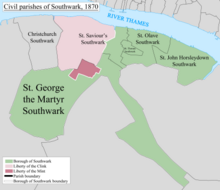Liberty of the Clink
The Liberty of the Clink was an area in Southwark , on the south bank of the Thames , across from the City of London . Although it belonged to the county of Surrey until 1889 , this Liberty was not under the jurisdiction of the High Sheriff of Surrey , but under that of the Bishop of Winchester , who was usually either the Lord Chancellor or Lord High Treasurer of the king.
Beginnings
The Liberty was originally the northeastern part of the ' Hide of Southwark', an area of land that King Henry I gave to the priory of the Benedictine monastery Bermondsey sometime in the years 1104-1109 . The monastery sold the land around 1149 to Henry von Blois , Bishop of Winchester and younger brother of King Stephen , who wanted to set up a domicile for his government duties in London.
The diocese administration referred to it as the "Manor of Southwark", meaning the manor house and lands of the bishop in Southwark. It was also known as the "Liberty of Winchester". The Liberty (Exposed a jurisdiction of the manorial system ) has been set with the seal on the transaction by King Stephen in force. It covered about 28 hectares.
Construction of a palace and prison
The bishop's residence, Winchester Palace , was built here and was initially surrounded by parkland. In 1151 the Clink prison was built at the western end . It is unclear whether the prison got its name from the Liberty or gave it to it. The origins of the name could be onomatopoeic , such as the sound of chains dragging behind prisoners, or the banging of the bolt on prison doors. The first mention of the "Liberty of the Clink" was in 1530; The nickname could also have been used informally to avoid confusion with the other mansions in Southwark.
Special freedoms
Since the Liberty was outside the jurisdiction of the City of London, as well as that of the Surrey county authorities, activities that were strictly prohibited in those areas were allowed in the Liberty of the Clink. In 1161, for example, Bishop Heinrich von Blois received permits from King Heinrich II to practice prostitution and to run brothels . The ladies of the trade were soon known as Winchester Geese and many were buried in the Cross Bones poor cemetery, closed in 1853 . To have been of "bitten a Winchester Goose", meant a sexually transmitted disease to have. For some time the English word for goose bumps was also used in this connotation for syphilis .
So within the Liberty of the Clink, besides animal hunting , such as bear- and bullbaiting , theatrical plays, which were banned in London, were also permitted. The most famous theater was William Shakespeare's Globe Theater . Other houses in the district, or directly adjacent, were The Rose and The Swan .
administration
The Liberty was in the Civil Parish of St. Margaret until 1539 when it came to the Parish of St. Savior (now Southwark Cathedral ).
In an official order issued in 1786 ("An Act for paving, cleansing, lighting and watching the Streets, Lanes and other publick Passages and Places, within the Manor of Southwark, otherwise called The Clink"), the Clink Paving Commissioners were appointed, which from then on the administration of the Liberty was incumbent. There are still bollards with the inscription "Clink 1812", which date from the time of the Commissioners. As an urban area of London, it was incorporated into the St. Saviors District. The tasks of the paving commissioner were taken over by the Metropolitan Board of Works in 1855 .
Incorporation
During the era of the Commonwealth of England , episcopalism was abolished and the Liberty was sold to a private owner at its beginning in 1649. It was returned to the bishop during the Stuart Restoration . Clink Prison was destroyed by fire in 1780, as was the Bishop's Palace in 1814. In 1863 the rights of the Bishop of Winchester to the Liberty were transferred to ecclesiastical institutions of the Church of England . In 1889, the Liberty was repealed under the Local Government Act 1888 , when all of the remaining Liberties in their surrounding counties were merged to form the County of London . Today, in addition to the bollards mentioned, the prison museum and a remains of the palace ruins, only Clink Street and Winchester Walk are reminiscent of the former area of the Liberty of the Clink.
Individual evidence
- ^ A b c Matthew Lewis: Medieval Britain in 100 Facts , Amberley Publishing Limited 2015, ISBN 978-1-4456-4735-7 in the Google book search
- ^ Anthony D. Mills: Oxford Dictionary of London Placenames p. 50, Oxford University Press 2001, ISBN 0-19-280106-6
- ↑ Take Our Word For It. Issue 199, p. 4
- ^ Public Act, 26 George III, c. 120 , in The National Archives.
- ↑ The Liberty of the Clink depiction in "Visit Bankside" .
Web links
Coordinates: 51 ° 30 ′ N , 0 ° 6 ′ W
